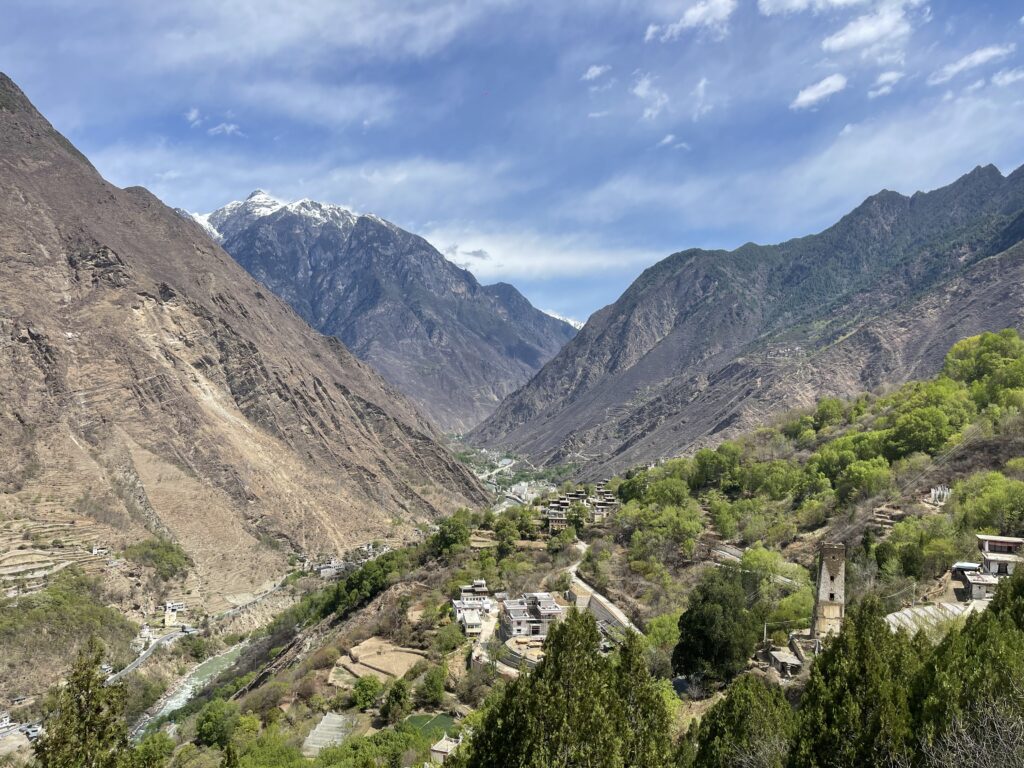Danba County (丹巴县), located in the Garzê Tibetan Autonomous Prefecture in Sichuan Province, China, is renowned for its stunning natural landscapes, unique architecture, and rich Tibetan culture. Often referred to as the “Kingdom of Thousands of Ancient Watchtowers,” Danba is a picturesque destination, known for its photogenic Tibetan villages, rivers, and verdant valleys nestled within the Hengduan Mountains.

Danba Ancient Watchtowers
Danba is famous for its ancient stone watchtowers, which can be found across the county. These structures are often built on ridges overlooking villages and date back hundreds of years, serving as defense, communication, and observation points.
Architectural Marvel: The towers are built without mortar and stand impressively tall, some reaching up to 60 meters. Their unique, tapered design and durability have made them iconic structures in Tibetan architecture.
Photography and Exploration: The watchtowers create a captivating landscape, especially when surrounded by mountain scenery and Tibetan-style villages, making Danba a paradise for photographers.
Jiaju Tibetan Village
Jiaju Village, often considered one of the most beautiful Tibetan villages in China, is known for its traditional Tibetan houses set against a backdrop of mountains and forests.
Traditional Tibetan Architecture: The houses feature white walls, red roofs, and decorative patterns, with each home uniquely adorned and situated within lush terraced fields and fruit orchards.
Cultural Immersion: Many families offer homestay experiences, allowing visitors to experience Tibetan hospitality, try local foods, and learn about the Tibetan way of life.
Seasonal Beauty: The village is particularly beautiful in spring when peach blossoms bloom and in autumn when the landscape is vibrant with fall colors.
Suopo Village and Watchtowers
Suopo Village is another area in Danba known for its concentration of watchtowers. The village has a rich historical significance and provides a unique glimpse into the traditional defense systems of the Tibetan Plateau.
Dense Cluster of Watchtowers: The watchtowers in Suopo are among the best-preserved in the region, making it one of the best places to appreciate these historical structures up close.
Spectacular Views: Suopo Village, located along a river valley and surrounded by mountains, offers stunning views of both the watchtowers and the natural landscape.
Tibetan Culture: Walking through Suopo allows visitors to experience traditional Tibetan culture in a rustic setting, from local crafts to Tibetan-style homes and temples.
Zhonglu Tibetan Village
Zhonglu is another traditional Tibetan village known for its serene atmosphere, dramatic landscapes, and authentic Tibetan lifestyle.
Cultural Heritage: Zhonglu Village is less visited, offering a more peaceful and immersive experience of Tibetan culture.
Nature and Hiking: With surrounding forests, terraced fields, and the Dadu River Valley nearby, Zhonglu is perfect for scenic hikes and offers panoramic views of the mountains and river below.
Traditional Tibetan Life: Zhonglu offers an authentic experience of Tibetan customs and traditions, and travelers can witness daily life, including farming practices and Buddhist rituals.
Beauty Valley (Meiren Valley)
Beauty Valley, named for the local belief that Danba produces beautiful women, is a scenic area with rivers, waterfalls, and traditional Tibetan architecture.
Natural Scenery: The valley features lush vegetation, rivers, and streams that flow from the mountains, making it a peaceful and picturesque location.
Cultural Significance: Many Tibetan women in Danba are known for their elaborate traditional clothing and jewelry, and the valley is home to several festivals and cultural events throughout the year.
Festivals: During local festivals, villagers gather in traditional attire, giving visitors a unique chance to observe and participate in the celebrations.
Dadu River
The Dadu River runs through Danba County, carving out beautiful valleys and providing life to the surrounding villages and grasslands.
Rafting and Boating: The Dadu River offers rafting and boating activities, providing a thrilling way to enjoy the county’s natural scenery.
Scenic Walks: Visitors can walk along parts of the river to take in the landscape, watch for wildlife, and enjoy views of the surrounding Tibetan villages.
Historic Importance: The river played a significant role during the Long March of the Red Army, adding historical depth to the scenic beauty of the area.
Tips for Visiting Danba County
- Best Time to Visit: Spring (April-May) and autumn (September-October) are the best times to visit Danba. The weather is mild, and the natural scenery is especially beautiful during these seasons.
- Altitude: Danba’s altitude is moderate compared to other Tibetan regions, generally between 1,800 and 2,500 meters. However, it’s still wise to acclimate gradually, especially if traveling from a lower altitude.
- Getting There: Danba is accessible by road from Chengdu, the capital of Sichuan Province, which takes approximately 6–8 hours by car or bus. Roads are mountainous and winding, so hiring an experienced driver is recommended.
- Cultural Etiquette: Respect local customs and religious sites. Always ask permission before taking photos of people and religious artifacts, and avoid touching sacred objects in monasteries and temples.
- Accommodation: Danba offers various lodging options, including hotels and family-run guesthouses in the Tibetan villages, especially in Jiaju. Homestays provide a cultural experience but often have basic facilities.
- Packing Essentials: Due to varying weather conditions, it’s best to bring layers, including warm clothing, especially for cooler evenings. Comfortable shoes, sunscreen, and rain protection are also recommended for outdoor activities.
Danba County, with its ancient watchtowers, picturesque Tibetan villages, and cultural richness, offers travelers a unique combination of history, natural beauty, and Tibetan heritage. Whether exploring the famous watchtowers of Suopo and Jiaju, hiking through lush valleys, or experiencing local traditions in a Tibetan homestay, Danba provides an unforgettable glimpse into the life and landscapes of the Tibetan Plateau.
Rongdrak County is divided into 9 towns and 2 townships.
- Drakgo Town
- Drakteng Town
- Gesheta Town
- Donggu Town
- Mudori Town
- Gyagyu Town
- Gudzong Town
- Golung Town
- Daddo Town
Bawang, Sogbo and Qugsug townships.
 Tibet World Travel Tibet Tour, Tibet Trip, Tibet Travel, Tibet Train, Tibet Trekking,
Tibet World Travel Tibet Tour, Tibet Trip, Tibet Travel, Tibet Train, Tibet Trekking,
